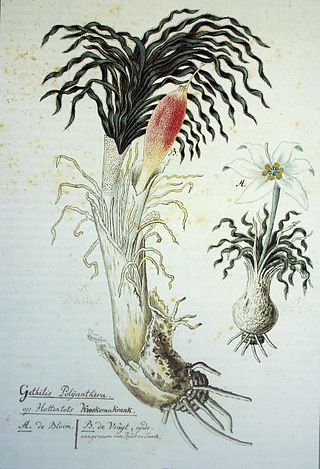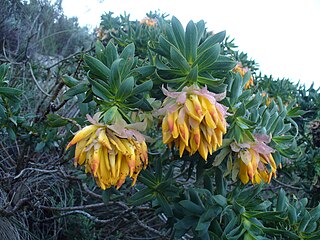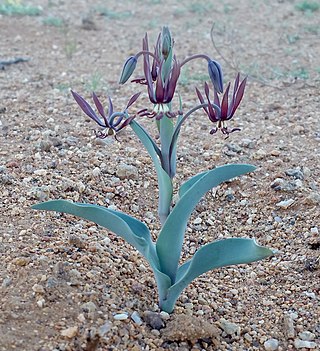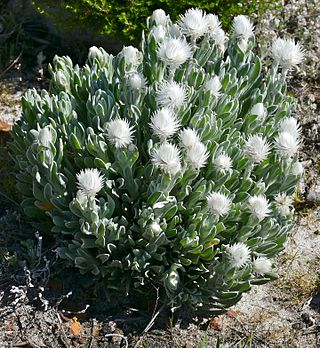
Amaryllis is the only genus in the subtribe Amaryllidinae. It is a small genus of flowering bulbs, with two species. The better known of the two, Amaryllis belladonna, is a native of the Western Cape region of South Africa, particularly the rocky southwest area between the Olifants River Valley and Knysna.

Senecio is a genus of flowering plants in the daisy family (Asteraceae) that includes ragworts and groundsels.

Freesia is a genus of herbaceous perennial flowering plants in the family Iridaceae, first described as a genus in 1866 by Christian Friedrich Ecklon (1886) and named after the German botanist and medical practitioner, Friedrich Freese (1795-1876). It is native to the eastern side of southern Africa, from Kenya south to South Africa, most species being found in Cape Provinces. Species of the former genus Anomatheca are now included in Freesia. The plants commonly known as "freesias", with fragrant funnel-shaped flowers, are cultivated hybrids of a number of Freesia species. Some other species are also grown as ornamental plants.

Osteospermum, is a genus of flowering plants belonging to the Calenduleae, one of the smaller tribes of the sunflower/daisy family Asteraceae. They are known as the daisybushes or African daisies. Its species have been given several common names, including African daisy, South African daisy, Cape daisy and blue-eyed daisy.

Kniphofia is a genus of perennial flowering plants in the family Asphodelaceae, first described as a genus in 1794. The species are native to Africa. Common names include tritoma, red hot poker, torch lily and poker plant.

Haworthia is a large genus of small succulent plants endemic to Southern Africa (Mozambique, Namibia, Lesotho, Eswatini and South Africa).

Syncarpha is a genus of herbaceous flowering plants in the family Asteraceae. The flowers are known by the common name: everlastings. The genus is endemic to the fynbos of the Eastern and Western Cape in South Africa.

Gethyllis, commonly called Kukumakranka, Koekemakranka, or Kroekemakrank, is a genus of bulbous plant in the Amaryllid family with some 33 accepted species. It is native to the Cape Provinces, the Northern Provinces and the Free State of South Africa, as well as Botswana and Namibia.

Anthemideae is a tribe of flowering plants in the family, Asteraceae, and the subfamily Asteroideae. They are distributed worldwide with concentrations in central Asia, the Mediterranean Basin, and southern Africa. Most species of plant known as chamomile belong to genera of this tribe.

Wurmbea is a genus of perennial herbs in the family Colchicaceae, native to Africa and Australia. There are about 50 species, with about half endemic to each continent.

Stirtonanthus is a South African genus of flowering plants in the family Fabaceae. It includes three species of shrubs native to the Cape Provinces of South Africa. They grow in fynbos at medium to high elevations. Each species is highly localized. It belongs to subfamily Faboideae.
Anderbergia is a genus of flowering plants in the family Asteraceae described as a genus in 1996.
Adenoglossa is a genus of flowering plants in the daisy family described as a genus in 1976. There is only one known species, Adenoglossa decurrens, endemic to the Cape Provinces of South Africa.
Hilliardia is a monotypic genus of South African flowering plants in the daisy family. It only contains one known species, Hilliardia zuurbergensis(Oliv.) B.Nord.

Liparia is a genus of flowering plants in the legume family, Fabaceae. It includes 20 species native to the Cape Provinces of South Africa. It belongs to the subfamily Faboideae.

Ornithoglossum is a genus of plants native to southern Africa, some of which are widely cultivated as ornamentals. Nine species are currently recognized, as of April 2014:
Capelio is a genus of flowering plant in the Asteraceae first described as a genus in 1836 with the name Alciope. It was renamed Capelio in 2002 after it was determined that the name Alciope was not legitimately published according to international nomenclatural rules. Capelio is a taxonomic anagram derived from the former name Alciope.
Adenanthellum is a genus of flowering plants in the daisy family, Asteraceae, described as a genus in 1979.
Osteospermum ilicifolium is a species of flowering plant in the aster family, Asteraceae. It is endemic to the Cape Provinces in South Africa.

Syncarpha vestita is a species of flowering plant. It belongs to the genus Syncarpha, and family Asteraceae. It is endemic to the Cape Provinces of South Africa.













